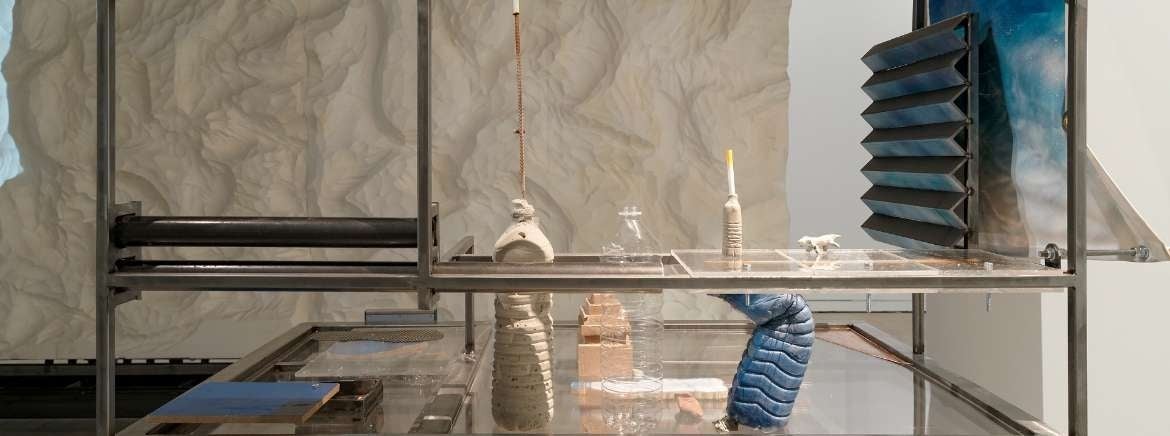En torrent et second jour

Exhibition curated by Mihnea Mircan, curator.
« Neïl Beloufa’s video works do not so much deconstruct filmic conventions, as they un-build them, tear apart and reassemble the cinematic apparatus into new continuities. His characters inhabit precarious stages, meant to obstruct or facilitate the movements of the camera, rather than accommodate stories of becoming. Tracking shots, dialogues, half-gestures, segmented or cloned scenographies fictionalize each other to a point of cinematic self-display. This logic of dismantling extends into the environments Beloufa constructs around his moving images – a montage of material translations and unstable equivalents, of palpable film-stills from a process in many ways similar to his handling of video technique and narrative.
It is these installation correlates – Beloufa’s labyrinthine ‘projection rooms’, or, seen differently, his sculptural making-of’s – whose syntax and role are emphasized (an accentuation that comes close to a reversal) in the artist’s project for the Fondation Ricard. Never at ease with their status as props, these objects are animated and documented, moved and movied, allowed to outgrow any clear separation of figure, ground and importance in the hierarchy of experience. The interface embodies and takes over the role of protagonist: the converse of a Pygmalion moment – where the pedestal would come alive –, or an echo of modern anxieties about a conspiracy of screens and viewing machines, encroaching upon the bodies and souls of viewers.
Neïl Beloufa experiments with a lively hypertrophy of display, with multiple configurations of frame and that which is framed, mirror and mirroring. ‘En torrent et second jour’ works through a messy notion of realism and mimesis, where figures and grounds, transmissions and screens camouflage one another. The initial mimetic equation – that links films and the sculptural assemblages ostensibly made for the viewing of those films, through the structural similarities in their articulation – expands into the mimesis of our visual regime: one that binds erratic images and disoriented users, competing for meaning and dispossessing each other of time.
As opposed to trying to keep up with the impetus of making and un-making in the installation for Fondation Ricard, to wrest sense from its mazes and domesticate it textually, the following notes focus on Brune Renault, a 2010 short that both occupies a central position in the exhibition and interweaves in a particular way the conceptual and visual maneuvers sketched above. Beloufa notes that “Brune Renault is a looped fiction that happens in a car sliced in four parts, resting on small wheels – basically a sculpture. Since we can open the car, implausible camera shots move in and out of the object. I wanted the sculpture to mutate into a functional object, once viewers were starting to follow the fiction.”
If viewers are indeed mesmerized into following this fiction – a constructive fiction of breaking apart and mending, of fragments held together by the camera shots, by sculptural and digital montage –, this hypnotic effect might be akin to a vertigo of all possible combinations: a logical netherworld where all intersections of camera and its stilled or animate objects are examined. An animation – somehow autonomous, abstracted from the animated subject – that pushes and pulls at scenes and characters.
It could be argued that the variable perspectives on and distances from the segments of the car recompose the vehicle into an anamorphic object. Regular anamorphosis converges distinct vanishing points within the same picture plane, each reducing the other’s object to a smudge of colour: in Hans Holbein’s painting, the ambassadors and the skull are each other’s peripherally perceived blur. Brune Renault meshes chronologies, accelerations and slow motions, title and credits in the wrong place on the timeline of the work, flickers of light suggesting speed, absolute stillness and the uneasy, vacuous dialogue between the four characters – all held in negative unity by zooms and transversal shots.
Anamorphosis here reconciles, in order for the film to exist, a discomposed set and the protagonists’ inability to occupy it and fulfil their part in the performative contract. And perhaps anamorphosis indirectly indicates that the only solid identity, or self-contained reality we are offered is that of the camera itself, its technical integrity and unhindered recording capacity, to-ing and fro-ing across a spectrum of actions and significance, circling the defenceless, exposed insides and relays of the film’s making. A tri-dimensional anamorphosis, maybe, activated by the rolling (as they used to say) of the camera and by that other invisible activity, the labour required by building and re-building the set, to allow the self-referential relations the camera patiently weaves.
A film of filming, with the set design as its idiosyncratic deus ex machina. A space that recoils and repels, and a persistent sense of distance, like a transparent sheet of emptiness separating viewers from work, barring sensuous contact with it. As a last hypohthesis, this is perhaps the distance (or equal to the distance) separating an artifice that has been revealed from the truth. »
Minhea Mircan, March 2014










